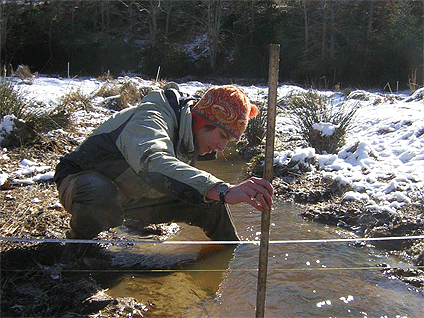Graduate Students
There are opportunities to participate in research projects related to the ecology of tidal freshwater rivers and other topics. If you have an interest, please contact me and visit the graduate program web page for the VCU Center for Environmental Studies or the graduate program web page for the Integrated Life Sciences PhD Program.

Recent Students and their Projects:
Rachel Henderson (MS 2021 Environmental Studies) – Rachel’s project focused on the factors influencing water clarity in upper estuarine segments of the James and York. We found that inorganic suspended particulate matter was the primary agent causing poor water clarity in these estuaries. For the sub-estuaries of the York (Pamunkey and Mattaponi), dissolved color originating from wetland sources was also an important factor. Long-term data suggest that water clarity is improving but has not yet reached the point where the growth of submerged aquatic vegetation would dominate over phytoplankton. A paper based on our research is currently in review at Estuaries & Coasts.
Jack Ryan (MS 2020 Environmental Studies) – Jack’s project investigates the feasibility of restoring endangered freshwater mussels to urban streams. Mussels have the potential to provide important ecosystem services by filtering water, removing sediment and other particulates, and promoting in-stream denitrification. Recent advances in mussel propagation allow the possibility of restoring them to habitats where they likely once occurred, but have been extirpated due to poor water quality conditions. Jack placed mussels in cages in three urban streams, two non-urban streams to assess their growth, survivorship and physiological status. This project is being done in collaboration with Rachel Mair at the Harrison Lake National Fish Hatchery .
Joe Famularo (MS 2019 Biology) – Joe’s project focused on nutrient limitation of urban and non-urban streams in central Virginia. Urban streams exhibit higher nitrogen concentrations in comparison to nearby forested streams and therefore we expected that they would respond more strongly to additions of phosphorus. We were surprised to find that there were no consistent differences in nitrogen vs. phosphorus limitation among these streams. We did find that urban streams provide a high level of biogeochemical functioning in removing N and P and preventing their downstream transport.
Rikki Lucas (MS 2019 Biology) – Rikki’s project focused on the hydrologic and geomorphological properties of urban streams. This work was conducted as part of our urban stream monitoring project for the City of Richmond. Although the Urban Stream Syndrome predicts poor hydrologic functioning of these streams, we found that urban streams were quite variable in their capacity to store water for short periods of time. Results from this study will be useful for interpreting differences in water quality among these streams, and may help to inform stream restoration efforts. We are grateful to our colleagues at the USGS Richmond office for their technical advice on this project.
Spencer Tassone (MS 2017 Biology) – Spencer compiled almost a quarter million measurements of dissolved oxygen concentrations collected by automated monitoring stations along the James River Estuary. These data were used to look at longitudinal and inter-annual variability in ecosystem metabolism (the balance between production and respiration). Along the way, we tested two models (Bayesian and book-keeping) for deriving metabolism estimates from diel oxygen data.
Michael Beck (MS 2017 ENVS) – Michael was interested in studying the effectiveness of a model wastewater treatment system installed at the VCU Rice Center. The property is not well suited to the use of a standard septic system and relies instead on spray irrigation into the surrounding forest. The data show that the forest-soil complex is effectively retaining the additional N inputs. Longer-term studies, carried out in collaboration with Forest Ecologist Chris Gough, are looking at forest responses to these N amendments.